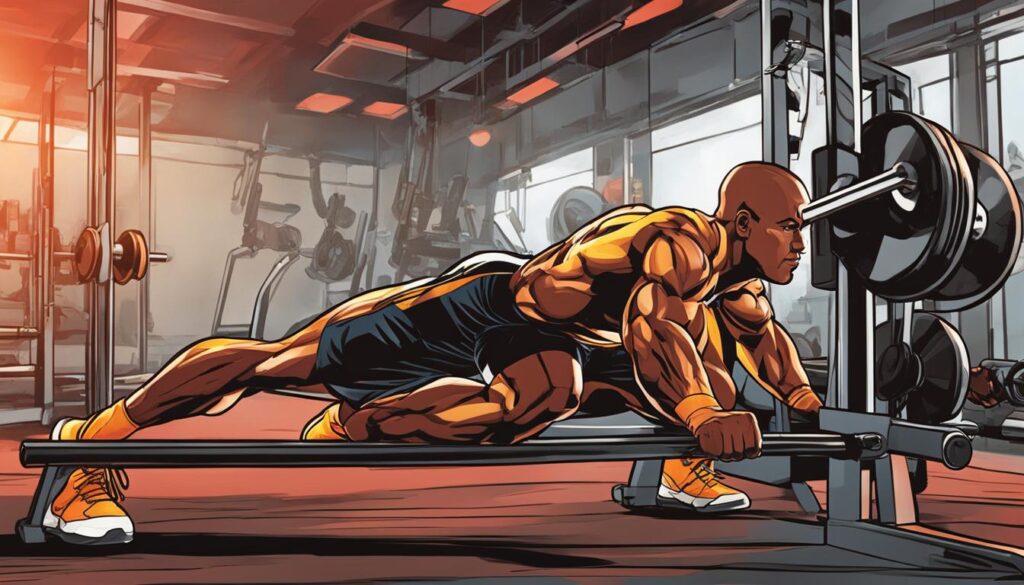Complete Guide: what muscle does hip thrust work
Welcome to my complete guide on the hip thrust exercise! If you’ve ever wondered what muscle does hip thrust work and how it can benefit your glute strength, you’re in the right place. In this article, I will provide a comprehensive overview of the hip thrust exercise, its impact on muscle development, and tips on incorporating it into your fitness routine.
The hip thrust exercise has gained immense popularity in recent years, primarily for its ability to target and strengthen the glute muscles. Whether you’re an athlete looking to enhance your performance or someone aiming to sculpt a toned backside, the hip thrust can be a valuable addition to your workout regimen.
Key Takeaways
- Hip thrust exercise targets the glute muscles, including the gluteus maximus and gluteus medius.
- Proper form and technique are crucial to maximize the benefits of the hip thrust and avoid injury.
- Incorporating variations of the hip thrust can help target different muscle groups and prevent workout plateau.
- Consistency and progressive overload are key to achieving optimal results with the hip thrust.
- Including pull exercises and designing a well-rounded fitness split can further enhance muscle development.
Understanding the Hip Thrust Exercise
The hip thrust exercise is a highly effective exercise that targets the glute muscles, making it a popular choice for those looking to develop strong and toned glutes. This compound exercise not only helps build strength but also improves hip extension and overall lower body power.
To perform a hip thrust correctly, follow these step-by-step instructions:
- Set-up: Sit on the ground with your upper back resting against a stable bench or elevated platform. Place a barbell or a weighted plate across your hips.
- Positioning: Bend your knees, placing your feet flat on the ground about hip-width apart. Your shins should be perpendicular to the ground.
- Engagement: Drive your feet into the ground and push your hips up towards the ceiling, squeezing your glutes at the top of the movement.
- Control: Lower your hips back down, maintaining control throughout the movement. Avoid fully resting your hips on the ground between repetitions.
- Repetitions: Aim for 8-12 repetitions per set, focusing on maintaining proper form and engaging the glutes throughout the exercise.
When performing the hip thrust, it’s important to focus on using the glutes to drive the movement rather than relying solely on the lower back or hamstring muscles. By effectively targeting the glutes, the hip thrust exercise can help strengthen and tone these muscles, leading to improved athletic performance and enhanced overall aesthetics.
“The hip thrust is a fantastic exercise for targeting the glutes. Its ability to isolate and engage the glute muscles makes it an essential addition to any lower body training routine.” – Dr. Emily Davis, Ph.D. in Exercise Science
Regularly incorporating the hip thrust exercise into your workout routine can provide numerous benefits, including:
- Increased glute strength and definition
- Improved hip extension and power
- Enhanced athletic performance in activities such as running, squatting, and jumping
- Reduced risk of lower back pain and injury
The Muscles Targeted by Hip Thrust
The hip thrust exercise is highly effective in targeting and strengthening specific muscles in the body. By incorporating this exercise into your fitness routine, you can specifically focus on developing the gluteus maximus, gluteus medius, and hamstrings. These are the primary muscle groups engaged during the hip thrust, making it an excellent exercise for glute activation and overall lower body strength.
The gluteus maximus, the largest muscle in the gluteal region, plays a significant role in hip extension and is intensively worked during the hip thrust. As you perform the exercise, the gluteus maximus contracts, helping to lift your hips off the ground and generate power in the movement.
Additionally, the gluteus medius, located on the outer surface of the pelvis, also plays a vital role in hip thrust exercises. This muscle helps stabilize the pelvis during the movement, ensuring proper alignment and preventing any unwanted lateral shifts.
The hamstrings, a group of muscles located behind the thigh, are also activated during hip thrust exercises. As you extend your hips upward and squeeze your glutes at the top of the movement, the hamstrings engage to support the hip extension and contribute to overall lower body strength and stability.
Including hip thrust exercises in your workout routine can provide numerous benefits such as improved glute strength, enhanced muscle tone, and increased lower body power. By targeting these specific muscle groups, you can effectively develop and shape your glutes while strengthening the surrounding muscles to promote better overall fitness.
| Muscles Targeted by Hip Thrust | Description |
|---|---|
| Gluteus Maximus | The largest muscle in the gluteal region responsible for hip extension and generating power in the movement. |
| Gluteus Medius | Located on the outer surface of the pelvis and provides stability during hip thrust exercises. |
| Hamstrings | Group of muscles behind the thigh that engage to support hip extension and contribute to lower body strength. |
Incorporating Hip Thrust into Your Fitness Routine
Now that you understand the benefits of the hip thrust exercise and the muscles it targets, it’s time to incorporate it into your fitness routine. By adding hip thrusts to your workouts, you can maximize glute strength, enhance muscle development, and take your fitness journey to the next level.
Finding the Right Frequency, Sets, and Repetitions
When it comes to incorporating hip thrusts into your routine, finding the right frequency, sets, and repetitions is key. Aim to perform hip thrusts 2-3 times per week, allowing for rest days in between to allow your muscles to recover and adapt.
Start with 3 sets of 10-12 repetitions and gradually increase the intensity by adding more sets or increasing the weight. Remember to maintain proper form throughout each repetition to ensure maximum effectiveness and minimize the risk of injury.
Varying Your Hip Thrust Routine
To prevent workout plateaus and keep your routine interesting, it’s essential to vary your hip thrust routine. There are several variations of the hip thrust exercise that you can incorporate to target different muscle groups and challenge your body in new ways.
Here are three popular variations to consider:
- Single-Leg Hip Thrust: This variation helps to improve balance and stability while targeting each glute individually. Perform the exercise with one leg extended straight out while lifting your hips.
- Sumo Stance Hip Thrust: By adopting a wider stance and turning your toes out slightly, you can place more emphasis on the inner thighs and adductors, in addition to targeting the glute muscles.
- Banded Hip Thrust: Incorporating resistance bands adds an extra challenge to the exercise by increasing tension throughout the movement. Loop a resistance band around your thighs and perform hip thrusts as usual.
By incorporating these variations into your routine, you can continue to challenge your muscles, break through plateaus, and ensure consistent progress.
Remember to consult with a fitness professional or personal trainer to ensure proper form and technique when performing the hip thrust exercise and its variations.

Adding hip thrusts to your fitness routine can help enhance glute strength, improve muscle development, and take your workouts to new heights. With the right frequency, sets, and repetitions, along with incorporating variations of the exercise, you can target different muscle groups, prevent plateaus, and continue progressing on your fitness journey.
Conclusion
In conclusion, incorporating hip thrust into your fitness routine is essential for developing glute strength and overall muscle development. The hip thrust exercise targets the glute muscles, including the gluteus maximus and gluteus medius, resulting in toned and strengthened glutes. By regularly performing hip thrusts, you can achieve better posture, improved athletic performance, and enhanced lower body aesthetics.
Additionally, it is important to balance your workout routine by incorporating pull exercises to complement the hip thrusts. Pull exercises such as rows and pull-ups engage the muscles of the upper body, creating a well-rounded and balanced physique. This combination of push and pull movements ensures that you are targeting all major muscle groups effectively.
Furthermore, implementing a fitness split can help you optimize your results. A fitness split involves dividing your training sessions to focus on specific muscle groups on different days, allowing for adequate recovery and muscle growth. By including hip thrusts and pull exercises in your fitness split, you can create a well-structured workout routine that targets various muscle groups and promotes overall strength and development.
FAQ
What muscle does the hip thrust work?
The hip thrust primarily targets the glute muscles, specifically the gluteus maximus and gluteus medius. It is a highly effective exercise for strengthening and building the glutes.
How does the hip thrust benefit glute strength?
The hip thrust is a compound exercise that isolates and activates the glute muscles, leading to improved glute strength and development. It helps in enhancing performance in activities like running, squatting, and jumping.
Can anyone perform the hip thrust exercise?
Yes, the hip thrust exercise can be performed by individuals of various fitness levels. However, it is recommended to consult with a fitness professional or trainer to ensure proper technique and to avoid any potential injuries.
How often should I do hip thrusts in my fitness routine?
The frequency of hip thrusts in your fitness routine depends on your goals and current fitness level. For optimal results, it is generally recommended to perform hip thrusts 2-3 times a week, allowing enough rest and recovery between sessions.
Are there variations of the hip thrust exercise?
Yes, there are variations of the hip thrust exercise that can target different muscle groups and add variety to your routine. Some variations include single-leg hip thrusts, elevated hip thrusts, and resistance band hip thrusts.
What are the benefits of incorporating pull exercises into my routine?
Pull exercises, such as rows and pull-ups, are essential for balanced muscle development. They target the muscles in the upper body, including the back, biceps, and shoulders, helping to improve posture, strength, and overall fitness.
What is a fitness split and why is it beneficial?
A fitness split is a workout routine that divides training sessions into specific muscle groups or movement patterns for targeted training. It allows for better focus on individual muscle groups and prevents overtraining. Incorporating a fitness split can enhance muscle development, strength, and overall fitness.
